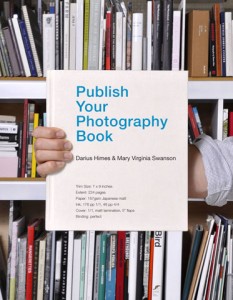PHOTOGRAPHERS. If you have an idea for a photography-book project but aren’t sure whether to self publish or seek a publisher, read the new book “Publish Your Photography Book” by photography-book-industry insiders Darius D. Himes and Mary Virginia Swanson. In addition to explaining the process of publishing a book of your photographs, the book highlights avenues you might not have considered and points out potential pitfalls.
 It also suggests that a photography book can help enhance your visibility and career. Himes and Swanson note that a well-executed photography book can provide you with a passport to the international photography scene and lead to exhibitions, talks, gallery walks, press interviews, and other opportunities.
It also suggests that a photography book can help enhance your visibility and career. Himes and Swanson note that a well-executed photography book can provide you with a passport to the international photography scene and lead to exhibitions, talks, gallery walks, press interviews, and other opportunities.
The book is divided into six sections.
Section 1: The Photography Book Phenomenon
Here, the authors explain why interest in books as a means of photographic expression is rising (and isn’t likely to be disappear any time soon). They point out that a photography book is more than a simple collection of printed photographs. It is often regarded as an autonomous art form.
Section 2: The Nuts and Bolts of Publishing
Whether you plan to self-publish or submit a proposal to a trade-book publisher, this section emphasizes the importance of clearly understanding your goals and developing a solid and engaging concept for your book.
The authors recommend examining your favorite photography books in more detail: What is the book about? Can you summarize the subject in one clear sentence? Is there a singular artistic vision? How is the cover designed? How are the pages laid out? How are the images sequenced? How much does the book stick with you after you’d viewed it?
Section 2 also talks about how publishers work, explains how to approach a publisher, and suggests things to look for when reading a publishing contract.
You’ll also learn how and when it makes sense to use print-on-demand technology to publish a book yourself and when you’d be better off going through a publisher.
For example, working with a publishing company involves collaborating with experienced professionals. This means you must be prepared to compromise in certain areas because the book is not just yours alone, but is also part of a company with a brand and a mission. When you self-publish, you must take on all steps of the process yourself, including hiring individuals who can help you execute your vision for the book and help market it.
The authors write that: “Successful self-publishers are those who are organized and entrepreneurial at heart, who know their audience, can effectively reach that audience, and have the financial and labor resources available to take on numerous roles.”
Section 3: The Making of Your Book
This section walks you through the three main stages of making a book: determining and shaping the editorial content, creating a design that enhances the content without overwhelming it, and working with a printer. Many of these decisions will be based on the concept you have developed and communicated for the book.
Section 4: The Marketing of Your Book
No matter whether you self-publish or have your book published, expect to play an active role in marketing and promoting your book. And you don’t wait until your book is printed to begin thinking about marketing. The first phase of your marketing strategy should begin well before your book is ready to ship. The second phase will be designed to extend the life of your book beyond its publication date.
“Publish Your Photography Book” provides tips for building mailing lists, creating a budget, maintaining a consistent brand identity, working with a publicist, mailing publicity packets, and using the Internet.
The authors also talk about opportunities for cross-marketing. For example, “If the photographs featured in your book can be acquired as limited-edition prints, or are available to be presented as a collection in a traveling exhibition, it is wise to include that information in all formats of your press materials.”
Section 5: Case Studies
Throughout Sections 1 through 4, you’ll find insightful interviews with publishers, editors, designers, photographers, and self-publishers that reinforce some of the advice presented in the book. Section 5 profiles seven photographers who have published one or more photography books:
- Alec Soth, “Sleeping by the Mississippi” and “The Last Days of W”
- Paula McCartney, “Bird Watching”
- David Maisel, “Library of Dust”
- Lisa M. Robinson, “Snowbound”
- Alex Webb and Rebecca Norris Webb, “Violet Isle”
- Sean Perry, “Transitory and Fairgrounds”
- John Gossage, “The Pond”, and “Stadt Des Schwarz”
One of the profiles quotes McCartney as saying, “It is very important that my books are artworks in themselves, not merely portfolios of my photographic projects…I think of books as a medium—like painting, photography, or sculpture—where all of the elements, including form, content, and materials are in dialogue with each other and are meaningful to the finished work.”
Section 6: Resources, Appendices, and Worksheets
This section includes 24 pages of helpful resources. For example, it includes: a diagram of the anatomy of a photography book; timelines for design, production, and marketing activities; a worksheet for preparing for your book; and guidelines for submitting a proposal to publishers. Also included are lists of: publishers; distributors; independent bookstores and dealers; festivals, awards, and trade events; blogs and book art resources; and online marketing resources.
About the Authors
Darius D. Himes was a founding editor of photo-eye Booklist and is a cofounder of Radius Books, a nonprofit company publishing books on the visual arts. Himes is a lecturer, consultant, and writer who has contributed to numerous publications. PDN magazine named him one of the fifteen most influential people in photography book publishing. For the past four years, Himes has been the lead judge of Blurb’s Photography Book Now Competition.
Mary Virginia Swanson is a consultant in the area of licensing and marketing fine-art photography. Swanson frequently lectures and conducts seminars and educational programs for photographers. She is a respected judge of competitions and awards as well as frequent portfolio reviewer.
If you want guidance about how to proceed with a specific book idea, Darius Himes and Mary Virginia Swanson offer one-on-one in-person or Skype consultations. To schedule a consultation, visit: http://www.publishyourphotographybook.com/
LINKS








